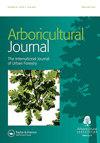林荫道乔木健康与风险状况评估与分类
Q3 Agricultural and Biological Sciences
引用次数: 1
摘要
本研究利用南非林波波省文达大学(UNIVEN)和路易斯·特里哈特镇(LTT)对林荫大道树木的健康和风险状况进行了评估和分类,以确定趋势并创建基线数据,用于评估未来的评估。在选定的7条街道进行了100%的调查。对每棵树的冠和茎直径、高度、冠长、树种、坐标、健康、稳定性和危害状况进行了评估。共评估树木621棵,包括92种。樟树和非洲油橄榄分别占林分的29.2%和11.5%。平均树密度UNIVEN (366.82/km)高于LTT (115.03/km)。LTT(65.9%)和UNIVEN(75.7%)的健康树木百分比较高。在这两个地区的临界稳定性类别中,凯撒皮尼亚(Caesalpinia ferrea)排名第一。只有LTT有1%的树木处于严重危险类别。常见的严重危害级结构缺陷包括基部腐烂,过度瘦弱的树枝。对管理的影响包括大规模盘存行道树、在狭窄街道上以中型树种取代大型树种,以及限制在公园和花园种植易发生危险的树木。本文章由计算机程序翻译,如有差异,请以英文原文为准。
Assessing and classifying the health and risk status of avenue trees
ABSTRACT This study assessed and classified avenue tree health and risk status using the University of Venda (UNIVEN) and Louis Trichardt town (LTT) in Limpopo Province of South Africa to determine trends and create baseline data against which future assessments can be evaluated. A 100% survey was conducted in seven selected streets. Crown and stem diameter, height, crown length, species, coordinates, health, stability, and hazard status were assessed for each tree. A total of 621 trees were assessed, comprising 92 species. Spathodea campanulata and Olea africana accounted for 29.2% and 11.5% of trees in LTT and UNIVEN, respectively. The average tree density was higher in UNIVEN (366.82/km) compared to LTT (115.03/km). Percentages of healthy trees were high in LTT (65.9%) and UNIVEN (75.7%). Caesalpinia ferrea ranked first in both locations in the critical stability class. Only LTT had 1% of trees in the severe hazard category. Common structural defects in the severe hazard class include basal decay, excessive lean, and weak branches. Management implications include large-scale inventory of street trees, replacement of large-sized with medium-sized tree species on narrow streets, and restriction of the planting of hazard-prone trees to parks and gardens.
求助全文
通过发布文献求助,成功后即可免费获取论文全文。
去求助
来源期刊

Arboricultural Journal
Agricultural and Biological Sciences-Agronomy and Crop Science
CiteScore
2.40
自引率
0.00%
发文量
28
期刊介绍:
The Arboricultural Journal is published and issued free to members* of the Arboricultural Association. It contains valuable technical, research and scientific information about all aspects of arboriculture.
 求助内容:
求助内容: 应助结果提醒方式:
应助结果提醒方式:


